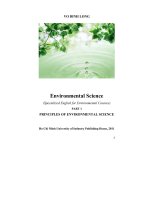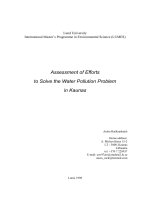Environmental Science
Bạn đang xem bản rút gọn của tài liệu. Xem và tải ngay bản đầy đủ của tài liệu tại đây (1.22 MB, 319 trang )
THIS PAGE IS
BLANK
NEW AGE INTERNATIONAL (P) LIMITED, PUBLISHERS
PUBLISHING FOR ONE WORLD
New Delhi · Bangalore · Chennai · Cochin · Guwahati · Hyderabad
Jalandhar · Kolkata · Lucknow · Mumbai · Ranchi
Visit us at www.newagepublishers.com
Copyright © 2006 New Age International (P) Ltd., Publishers
Published by New Age International (P) Ltd., Publishers
All rights reserved.
No part of this ebook may be reproduced in any form, by photostat, microfilm,
xerography, or any other means, or incorporated into any information retrieval
system, electronic or mechanical, without the written permission of the publisher.
All inquiries should be emailed to
ISBN (10) : 81-224-2330-2
ISBN (13) : 978-81-224-2330-3
PUBLISHING FOR ONE WORLD
NEW AGE INTERNATIONAL (P) LIMITED, PUBLISHERS
4835/24, Ansari Road, Daryaganj, New Delhi - 110002
Visit us at www.newagepublishers.com
P
R
E
F
A
C
E
Education is a process of development which includes the three major
activities, teaching, training and instruction. Teaching is social as well as
a professional activity. It is science as well as art. Modern education is not
in a sphere but it has a long and large area of study. Now a days most part
of the world population is facing different problems related with the nature
and they are studying the solutions to save the nature and global problems,
but on the second hand we even today do not try to understand our local
problems related to the nature. So for the awareness of the problems of
nature and pollution the higher education commission has suggested to
add the Environmental Science in the course of different levels.
Environmental Science is also well known as Environmental Studies in
the Indian Colleges and Universities. Before that it was the part of the
science but now a days it is a very common subject and higher education
commission has suggested including it as a general paper in all the courses.
Awareness in the field of environmental sciences is becoming a global
talk. People worldwide are realizing its importance as they are able to
smell a Polluted tomorrow. Careful handling of todays’ environment would
only serve as a legacy for tomorrows’ generation. Hence, we need to be
judicious in exploiting our resources optimally. To ensure a sustainable
development we need to know something about how our environment
works. Environment can be defined as the set of conditions that surround
an organism or the complex of socio cultural condition that affect an
individual. Environmental Science is the systematic, scientific study of the
environment in combination with living organisms.
Most of the universities have introduced this new content as course
of Environmental Science or Environmental Studies/Environmental
Science in B.Ed. Course. The present book has been written by including
some content of print and non-print media. Now this book is especially for
modified syllabus of B.T.C./B.Ed./ M.Ed. of Indian & Foreign Universities/
Training Institute & Education Colleges Recognized by National Council of
Teacher Education, New Delhi.
The author has consulted several books in designing, organizing and
preparing the script of this book. I express my sense of gratitude to all
sources which have been used directly or indirect1y for the instructional
material and the sequence. The credit goes to my well-wisher, who has
(vi)
helped me in this attempt. I warmly acknowledge her assistance extended
to me. The practical suggestions for the improvement and modification of
instructional material and sequence for the text are most welcomed in
this hope that book will prove useful to students and educators.
P
R
E
F
A
C
E
Dr. Y. K. Singh
AA-39, Suryodaya Vihar
Ansal Colony, Shastri Nagar
Kutti Chopla, Near PVC Mall, Meerut,
Uttar Pradesh, India
E-mail:
CONTENTS
Prefece
v
1.
Environmental Science: Definition, Scope and Importance
1
2.
Environmental Science: Natural Resources
3.
Environmental Science: Ecosystem
108
4.
Environmental Science: Biodiversity and Conservation
137
5.
Environmental Science: Pollution and its Factors
161
6.
Environmental Science: Social Issues
192
7.
Environmental Science: Human Population and Environment
220
8.
Environmental Science: Field Trip
246
9.
Environmental Science: Modern Methods
256
10.
Environmental Science: Modern Library
280
11.
Environmental Science: Modern and Effective Teacher
289
Glossary
301
Reference
310
10
THIS PAGE IS
BLANK
CHAPTER
1
Environmental Science :
Definition, Scope and Importance
INTRODUCTION
The science of Environment studies is a multi-disciplinary science because it comprises
various branches of studies like chemistry, physics, medical science, life science, agriculture,
public health, sanitary engineering etc. It is the science of physical phenomena in
the environment. It studies of the sources, reactions, transport, effect and fate of physical
a biological species in the air, water and soil and the effect of from human activity upon
these.
Environment Explained
Literary environment means the surrounding external conditions influencing
development or growth of people, animal or plants; living or working conditions etc. This
involves three questions:
1. What is Surrounded
The answer to this question is living objects in general and man in particular.
2. By what Surrounded
The physical attributes are the answer to this question, which become environment. In
fact, the concern of all education is the environment of man. However, man cannot exist or
be understood in isolation from the other forms of life and from plant life. Hence, environment
refers to the sum total of condition, which surround point in space and time. The scope of
the term Environment has been changing and widening by the passage of time. In the
primitive age, the environment consisted of only physical aspects of the planted earth' land,
air and water as biological communities. As the time passed on man extended his environment
through his social, economic and political functions.
3. Where Surrounded
The answer to this question. It is in nature that physical component of the plant earth,
viz land, air, water etc., support and affect life in the biosphere. According to a Goudie
1
2
ENVIRONMENTAL SCIENCE
environment is the representative of physical components of the earth where in man is an
important factor affecting the environment.
(i) Definitions of Environment : Some important definitions of environment are as
under:
1. Boring: ‘A person’s environment consists of the sum total of the stimulation
which he receives from his conception until his death.’
It can be concluded from the above definition that Environment comprises
various types of forces such as physical, intellectual, economic, political,
cultural, social, moral and emotional. Environment is the sum total of all the
external forces, influences and conditions, which affect the life,
nature, behaviour and the growth, development and maturation of living
organisms.
2. Douglas and Holland: ‘The term environment is used to describe, in the
aggregate, all the external forces, influences and conditions, which affect the
life, nature, behaviour and the growth, development and maturity of living
organisms.’
(ii) Scope of Environment: The environment consists of four segments as under:
1. Atmosphere: The atmosphere implies the protective blanket of gases,
surrounding the earth:
(a) It sustains life on the earth.
(b) It saves it from the hostile environment of outer space.
(c) It absorbs most of the cosmic rays from outer space and a major portion of the
electromagnetic radiation from the sun.
(d) It transmits only here ultraviolet, visible, near infrared radiation (300 to 2500
nm) and radio waves. (0.14 to 40 m) while filtering out tissue-damaging ultraviolate waves below about 300 nm.
The atmosphere is composed of nitrogen and oxygen. Besides, argon, carbon dioxide,
and trace gases.
2. Hydrosphere: The Hydrosphere comprises all types of water resources oceans,
seas, lakes, rivers, streams, reserviour, polar icecaps, glaciers, and ground
water.
(i) Nature 97% of the earth’s water supply is in the oceans,
(ii) About 2% of the water resources is locked in the polar icecaps and glaciers.
(iii)Only about 1% is available as fresh surface water-rivers, lakes streams, and
ground water fit to be used for human consumption and other uses.
3. Lithosphere: Lithosphere is the outer mantle of the solid earth. It consists
of minerals occurring in the earth’s crusts and the soil e.g. minerals, organic
matter, air and water.
4. Biosphere: Biosphere indicates the realm of living organisms and their
interactions with environment, viz atmosphere, hydrosphere and lithosphere.
ENVIRONMENTAL SCIENCE : DEFINITION, SCOPE AND IMPORTANCE
3
Element of Environment
Environment is constituted by the interacting systems of physical, biological and cultural
elements inter-related in various ways, individually as well as collectively. These elements
may be explained as under:
(1) Physical elements
Physical elements are as space, landforms, water bodies, climate soils, rocks and minerals.
They determine the variable character of the human habitat, its opportunities as well as
limitations.
(2) Biological elements
Biological elements such as plants, animals, microorganisms and men constitute the
biosphere.
(3) Cultural elements
Cultural elements such as economic, social and political elements are essentially manmade features, which make cultural milieu.
ENVIRONMENT STUDIES: IMPORTANCE
Importance of Environment Studies: The environment studies enlighten us, about the
importance of protection and conservation of our indiscriminate release of pollution into the
environment.
At
day by
besides
become
present a great number of environment issues, have grown in size and complexity
day, threatening the survival of mankind on earth. We study about these issues
and effective suggestions in the Environment Studies. Environment studies have
significant for the following reasons:
1. Environment Issues Being of International Importance
It has been well recognised that environment issues like global warming and ozone
depletion, acid rain, marine pollution and biodiversity are not merely national issues but are
global issues and hence must be tackled with international efforts and cooperation.
2. Problems Cropped in The Wake of Development
Development, in its wake gave birth to Urbanization, Industrial Growth, Transportation
Systems, Agriculture and Housing etc. However, it has become phased out in the developed
world. The North, to cleanse their own environment has, fact fully, managed to move ‘dirty’
factories of South. When the West developed, it did so perhaps in ignorance of the
environmental impact of its activities. Evidently such a path is neither practicable nor
desirable, even if developing world follows that.
3. Explosively Increase in Pollution
World census reflects that one in every seven persons in this planted lives in India.
Evidently with 16 per cent of the world's population and only 2.4 per cent of its land area,
there is a heavy pressure on the natural resources including land. Agricultural experts have
recognized soils health problems like deficiency of micronutrients and organic matter, soil
salinity and damage of soil structure.
4
ENVIRONMENTAL SCIENCE
4. Need for An Alternative Solution
It is essential, specially for developing countries to find alternative paths to an alternative
goal. We need a goal as under:
(1) A goal, which ultimately is the true goal of development an environmentally sound
and sustainable development.
(2) A goal common to all citizens of our earth.
(3) A goal distant from the developing world in the manner it is from the over-consuming
wasteful societies of the “developed” world.
5. Need To Save Humanity From Extinction
It is incumbent upon us to save the humanity from exinction. Consequent to our activities
constricting the environment and depleting the biosphere, in the name of development.
6. Need For Wise Planning of Development
Our survival and sustenance depend. Resources withdraw, processing and use of the
product have all to by synchronised with the ecological cycles in any plan of development our
actions should be planned ecologically for the sustenance of the environment and development.
7. Misra’s Report
Misra (1991) recognized four basic principles of ecology, as under:
(i) Holism
(ii) Ecosystem
(iii) Succession
(iv) Conversation.
Holism has been considered as the real base of ecology. In hierarchical levels at which
interacting units of ecology are discussed, are as under:
Individual
under:
(i) Impact of human activities on the environment,
(ii) Value system,
(iii) Plan and design for sustainable development,
(iv) Environment education.
Keeping in view the of goal of planning for environmentally sustainable development
India contributed to the United Nations Conference on Environment and Development
(UNCED), also referred to as “Earth Summit” held at Rio de Janciro, the Capital of Brazil,
3rd-14th June, 1992.
NEED FOR PUBLIC AWARENESS
It is essential to make the public aware of the formidable consequences of the
Environmental Degradation, if not retorted and reformative measures undertaken, would
ENVIRONMENTAL SCIENCE : DEFINITION, SCOPE AND IMPORTANCE
5
result in the extinction of life. We are facing various environmental challenges. It is essential
to get the country acquainted with these challenges so that their acts may be eco-friendly.
Some of these challenges are as under:
1. Growing Population
A population of over thousands of millions is growing at 2.11 per cent every year. Over
17 million people are added each year. It puts considerable pressure on its natural resources
and reduces the gains of development. Hence, the greatest challenge before us is to limit the
population growth. Although population control does automatically lead to development, yet
the development leads to a decrease in population growth rates. For this development of the
women is essential.
2. Poverty
India has often been described a rich land with poor people. The poverty and
environmental degradation have a nexus between them. The vast majority of our people are
directly dependent on the nature resources of the country for their basic needs of food, fuel
shelter and fodder. About 40% of our people are still below the poverty line. Environment
degradation has adversely affected the poor who depend upon the resources of their immediate
surroundings. Thus, the challenge of poverty and the challenge environment degradation
are two facets of the same challenge. The population growth is essentially a function of
poverty. Because, to the very poor, every child is an earner and helper and global concerns
have little relevance for him.
3. Agricultural Growth
The people must be acquainted with the methods to sustain and increase agricultural
growth with damaging the environment. High yielding varities have caused soil salinity and
damage to physical structure of soil.
4. Need to Ground water
It is essential of rationalizing the use of groundwater. Factors like community wastes,
industrial effluents and chemical fertilizers and pesticides have polluted our surface water
and affected quality of the groundwater. It is essential to restore the water quality of our
rivers and other water bodies as lakes is an important challenge. It so finding our suitable
strategies for consecration of water, provision of safe drinking water and keeping water
bodies clean which are difficult challenges is essential.
5. Development And Forests
Forests serve catchments for the rivers. With increasing demand of water, plan to
harness the mighty river through large irrigation projects were made. Certainly, these
would submerge forests; displace local people, damage flora and fauna. As such, the dams
on the river Narmada, Bhagirathi and elsewhere have become areas of political and scientific
debate.
Forests in India have been shrinking for several centuries owing to pressures of
agriculture and other uses. Vast areas that were once green, stand today as wastelands.
These areas are to be brought back under vegetative cover. The tribal communities inhabiting
forests respects the trees and birds and animal that gives them sustenance. We must recognise
6
ENVIRONMENTAL SCIENCE
the role of these people in restoring and conserving forests. The modern knowledge and
skills of the forest deptt. should be integrated with the traditional knowledge and experience
of the local communities. The strategies for the joint management of forests should be
evolved in a well planned way.
6. Degradation of Land
At present out of the total 329 mha of land, only 266 mha possess any potential for
production. Of this, 143 mha is agricultural land nearly and 85 suffers from varying degrees
of soil degradation. Of the remaining 123 mha, 40 are completely unproductive. The remaining
83 mha is classified as forest land, of which over half is denuded to various degrees. Nearly
406 million head of livestock have to be supported on 13 mha, or less than 4 per cent of the
land classified as pasture land, most of which is overgrazed. Thus, our of 226 mha, about
175 mha or 66 per cent is degraded to varying degrees. Water and wind erosion causes
further degradation of almost 150 mha This degradation is to be avoided.
7. Reorientation of Institutions
The people should be roused to orient institutions, attitudes and infrastructures, to suit
conditions and needs today. The change has to be brought in keeping in view India’s traditions
for resources use managements and education etc. Change should be brought in education,
in attitudes, in administrative procedures and in institutions. Because it affects way people
view technology resources and development.
8. Reduction of Genetic Diversity
Proper measures to conserve genetic diversity need to be taken. At present most wild
genetic stocks have been disappearing from nature. Wilding including the Asiatic Lion are
facing problem of loss of genetic diversity. The protected areas network like sanctuaries,
national parks, biosphere reserves are isolating populations. So, they are decreasing changes
of one group breeding with another. Remedial steps are to be taken to check decreasing
genetic diversity.
9. Evil Consequences of Urbanisation
Nearly 27 per cent Indians live in urban areas. Urbanisation and industrialisation has
given birth to a great number of environmental problem that need urgent attention. Over
30 percent of urban Indians live in slums. Out of India’s 3,245 towns and cities, only 21 have
partial or full sewerage and treatment facilities. Hence, coping with rapid urbanization is
a major challenge.
10. Air and water Population
Majority of our industrial plants are using outdated and population technologies and
makeshift facilities devoid of any provision of treating their wastes. A great number of cities
and industrial areas that have been identified as the worst in terms of air and water
pollution. Acts are enforced in the country, but their implement is not so easy. The reason
is their implementation needs great resources, technical expertise, political and social will.
Again the people are to be made aware of these rules. Their support is indispensable to
implement these rules.
ENVIRONMENTAL SCIENCE : DEFINITION, SCOPE AND IMPORTANCE
7
VARIOUS TYPES OF ENVIRONMENT
According to Kurt Lewin, environment is of three types which influence the personality
of an individual as under:
(a) Physical Environment,
(b) Social and Cultural Environment, and
(c) Psychological Environment.
These may be explained as under:
1. Physical Environment
Physical environment, refers to geographical climate and weather or physical conditions
wherein and individual lives. The human races are greatly influenced by the climate. Some
examples are as under:
(a) In the cold countries i.e. European countries the people are of white colour. Likewise,
in Asian and African countries, that is, in hot countries people are of dark complexion.
(b) The physique of an individual depends on climate conditions as the individual tries
to adjust in his physical environment.
(d) The human working efficiency also depends on the climatic conditions.
2. Social Environment
Social Environment includes an individual’s social, economic and political condition
wherein he lives. The moral, cultural and emotional forces influence the life and nature of
individual behaviour. Society may be classified into two categories as under:
(i) An open society is very conductive for the individual developement.
(ii) A closed society is not very conductive for the developenment.
3. Psychological Environment
Although physical and social environment are common to the individual in a specific
situation. Yet every individual has his own psychological environment, in which he lives.
Kurt Lewin has used the term ‘life space’ for explaining psychological environment. The
Psychological environment enables us to understand the personality of an individual. Boththe person and his goal form psychological environment.
If a person is unable to overcome the barriers, he can either get frustrated or completed
to change his goal for a new psychological environment. But adopting this mechanism, the
individual is helped in his adjustment to the environment.
STRUCTURE OF ENVIRONMENT
Environment is both physical and biological. It includes both living and non-living
components.
(i) Physical Environment
The Physical Environment is classified into three broad categories viz.
8
ENVIRONMENTAL SCIENCE
(i) Solid,
(ii) Liquid
(iii) Gas.
These represent the following spheres:
(i) The lithosphere (solid earth)
(ii) The hydrosphere (water component) and
(iii) The atmosphere
As such, the three basic of physical environment may be termed as under:
(i) Lithospheric Environment
(ii) Hydrospheric Environment
(iii) Atmospheric Environment
The scientists have classified them into smaller units based on different spatial scales,
e.g.
(i) Mountain Environment
(ii) Glacier Environment
(iii) Plateau Environment
(iv) Coastal Environment
(ii) Biological Environment
The biological of the environment consists of:
(i) Plants (flora)
(ii) Animals (fauna).
Thus, the biotic environment further be divided into floral environment and faunal
environment. All the organisms work to form their social groups and organizations at several
levels. Thus, the social environment is formed. In this social environment the organisms
work to derive matter from the physical environment for their sustenance and development.
This process gives birth to economic environment. Man claims to be most skilled and civilized
of all the organisms. This is the reason why his social organisation is most systematic. The
three aspects of man, e.g. physical, social and economic, function in the biotic environment
as under:
(i) The Physical Man
The ‘Physical Man’ is one of the organisms populations or biological community. He is
in need of basic elements of the physical environment like habitat (space), air, water and
food. Besides, like other biological populations, he releases wastes into the ecosystem.
(ii) The Social Man
The ‘Social Man’ performs the following functions:
(a) Establishing social institutions,
(b) Forming social organisations,
ENVIRONMENTAL SCIENCE : DEFINITION, SCOPE AND IMPORTANCE
9
(c) Formulating laws, principles and policies,
(d) Taking steps to safeguard his existence, interest and social welfare.
(iii) The Economic Man
The economic man derives and utilises resources from the physical and biotic environment
with his skills and technologies. The economic function makes the man an environment/
geomorphic process as he transports matter and energy from one component of the ecosystem
to the other. There may be any following two situations:
(a) His exploitative functions may be in harmony with the natural environment. Such,
functions do not necessarily involve change in the working of the ecosystem.
(b) These functions may exceed the critical limit. Consequently, the equilibrium of the
environment/ecosystem is disturbed and a great number of environment and
ecological problems crop up. These are determental to man him besides to whole
population of human species in a given ecosystem.
QUESTIONS
1. What is Environment? Discuss the scope of Environment.
2. Describe the importance of environment studies.
3. “The need for public awareness about environment is of vital importance.” Discuss.
4. Discuss the various types of environment.
Short Answer Type Questions
1. Define environments.
2. Discuss the scope of environment.
3. Write a note on the importance of environment studies.
4. Write a note on the need of public awareness about environment.
5. Write a note on physical environment.
6. Write a note on biological environment.
10
ENVIRONMENTAL SCIENCE
CHAPTER
2
Environmental Science :
Natural Resources
INTRODUCTION
A natural resource may be defined as any material given to us by nature which can be
transformed in a way that it becomes more valuable and useful.
For an example wood is used for making furniture. Yarn obtained from cotton is used
for weaving cloth. Likewise, various machine, tools and household goods are made of metals.
Now furniture, clothes, machine, tools are more valuable than their raw form i.e. raw form
i.e. wood, cotton and metal, respectively. The wood, metal resources. It is impossible to
obtain valuable items from any resources. Thus, water, minerals, forests, wildlife as well as
human beings are resources. Any material may be called, as a resource provided and
appropriate technology is available to transform that into more valuable goods.
Renewable and Non-renewable Resources
On the basis of continuity, the resources are classified as under:
(1) Renewable Resources
(2) Non-renewable Resources.
1. Renewable Resources
Resources, which can be renewed along with their exploitation, are always available for
use. Hence they are called renewable resources. For instance, forests are renewable. If trees
are felled for wood, original forest covers may be maintained through planning new trees
i.e. a forestation. Likewise, solar energy and wind energy are examples of renewable resources.
2. Non-renewable Resources
The formation of some resources like iron ore, coal, mineral oil etc. has taken several
thousand years. Once they are used in unlimited way, they cannot be easily replaced. Thus,
their exploitation at large scale will result in their fast depletion. Some such resources are
called non-renewable resources or exhaustible.
10
ENVIRONMENTAL SCIENCE : NATURAL RESOURCES
11
3. Cyclic Resources
For resources there is no final use as they can be used continuously. For example, water
used in industry and domestic ways can be cleaned and used again for similar or other
purpose. Such resources are given the name of Cyclic Resources.
FOREST RESOURCES
1. Importance of Forest Resources
The importance of forest resources can be explained as under:
1. Ecological Balance: Forests and wildlife are essential to maintain ecological
balance of an area.
2. Renewable Natural Resources: Forests are an important renewable natural
resources.
3. Eco-system: Trees dominate forest ecosystem; their species content varities in
different parts of the world.
4. Economic Development: Forest contributes to the economic development of the
country because they provide goods and services to the people and industry.
5. Environment Quality: The forest enchance the quality of environment by
influencing the life supporting system.
6. Safeguard against Pollution: Forest check air pollution and soil erosion. Thus,
they exercise safety and against pollution.
7. Soil Conservation: Forest save the hill-slopes from landslides.
8. Wind Erosion: In deserts, trees reduce wind erosion by checking wind velocity.
9. Check the Extension Balance: The forest checks strong gales and keeps the soil
intact beneath the roots of trees and thus checks extension of desert.
10. Maintains Ecological Balance: The forest check pollution of air through increasing
oxygen content of the air.
11. Attract Rainfall: By causing condensation of water vapour in clouds, forests attract
rains.
12. Control Floods: The floods are controlled because forests dry up rainwater like
sponge.
13. Linked with Cultural and Civilization: Forests are linked with our cultural
and civilization.
14. Supply of Raw Material: Forest supply wood, which is used as under:
(i) Fuel,
(ii) Raw material for various industries as pulp, paper, newsprint, board;
(iii) Timber for furniture items;
(iv) To be used in packing articles like fruits, tea etc.
(v) For preparing matches, sport goods etc.
ENVIRONMENTAL SCIENCE : NATURAL RESOURCES
13
15. Minor forest products: Some examples of minor forest products, are canes, gums,
resins, dyes, flocks, medicines, tannins, lac, fibres, katha etc.
1. For tribal people are provided with food like tuber, roots, leaves, fruits, meat
from birds and other animals etc.
16. Employment opportunities: About eight crore people are employed in wood based
industries like paper and match and small and cottage industries. Besides, those
who are employed in the forest department in various states.
17. Revenue Receipts: The forest provide Rs. 400 crores per year as revenue to the
government.
18. Fodder for Cattle: Forest provide fodder to cattle.
19. Foreign Exchange Earners: Forest produce a great number of articles like
essential oils, resins and dyes. Which find market in foreign countries. Nearly Rs.
50 crores are earned in foreign exchange through selling lac, terpentine oil and
sandal wood oil to abroad.
Thus, the forests are nation’s wealth. They are useful to us directly and indirectly.
Areas Covered with Forests in India
Forests are a estimated form time to time. Some data collected in the basis of researches
made, are as under:
Brewbaker (1984)
According to Brewbaker, to 2890, total forest are of the world in 1990 was nearly 700 Mha.
By 1975 it was reduced to 2890 Mha. It was also pointed out that it would be merely 2370 Mha
by 200 A.D. Major reduction will be in tropics and subtropics (40.2), shown in Figs. 2.2 and 2.3.
Fores t A re a in th e ye a r 1 9 7 2 -7 3
90000000
80000000
70000000
60000000
50000000
40000000
30000000
20000000
10000000
0
Fig. 2.2
D e lhi
Uttar P rad e s h
O ris s a
D ad ar & Nag ar
Ke rala
Haryana
And hra P rad e s h
1 9 7 2 -7 3 sq km
14
ENVIRONMENTAL SCIENCE
Forest A rea in the Year 1980-8
100000
80000
60000
40000
20000
0
D elhi
U ttar Pradesh
O rissa
D adar & N agar
Kerala
H aryana
Andhra Pradesh
1980-82 sq km
Fig. 2.3
C.F.C. (1980)
According to Central Forestry Commission (CEF) (1980) in India the forest cover was
around 74.8 Mha. It was 22.7% of the total land mass. A detailed study of forests carried
out by CEF reveals the position of forests in India as under:
(a) The tropical dry deciduous (38.7%).
(b) The tropical moist deciduous (30.9%) type.
(c) The tropical thorn 6.9%
(d) The tropical dry evergreen 0.1%
(e) The pure coniferous (high mountainous area) 6.3%
(f) The sal forest 16%
(g) The teak forest 13%
(h) The broad-leaved excluding Sal and Teak 55.8%
(i) The Bamboos including in plantations 8.8%
Ownership
(a) The total forest are nearly 96% (71.63 Mha) forest area is Government owned.
(b) 2.6% (1.95 Mha) forest area is owned by corporate bodies.
(c) 1.2 Mha forest area is in private owneship.
Total area under forests in different states during 1972-75 and 1980-82 is as under:
ENVIRONMENTAL SCIENCE : NATURAL RESOURCES
15
Total Forest Area (Sq. Km)
State/U.T.
1972-75
1980-82
Andhra Pradesh
49049
40435
Assam
21055
19796
Bihar
22687
20139
Gujrat
9459
5057
Haryana
757
401
Himachal Pradesh
15075
9130
J & K
22335
14361
Karnataka
29480
25656
Kerala
8611
7376
M.P.
108568
90215
Maharashtra
40682
30350
Manipur
15090
13575
Dadar & Nagar Haveli
177
70
Meghalaya
14390
12458
Nagaland
8154
8095
Tripura
6330
5138
Orissa
48383
39425
Punjab & Chandigarh
1120
499
Rajasthan
11294
5972
Tamil Nadu
16676
13187
U.P.
25869
21022
West Bengal
83476483
Sikkim
1761
2883
Arunachal Pradesh
51438
58104
Delhi
18
10
Goa, Daman & Diu
1221
1139
Mizoram
13860
11970
Total
551886
457046
State Percentage of Forests Area
The following is the list of percentage of total area in a state occupied by forests
(Fig. 2.4).
16
ENVIRONMENTAL SCIENCE
0 .9
0 .8
0 .7
0 .6
0 .5
0 .4
0 .3
0 .2
0 .1
0
A run ach al
P rad esh
B ihar
H im ac hal
P rad esh
Fig. 2.4
H ary ana
P u nja b
J am m u &
K a sh m ir
R ajas than
Tripura
U tta r
P rad esh
State percentages of forest area
1. Arunachal Pradesh
79%
2. Bihar
17%
3. Himachal Pradesh
48%
4. Harayana
2%
5. Punjab
2%
6. Jammu & Kashmir
61%
7. Rajasthan
4%
8. Tripura
50%
9. Uttar Pradesh
13%
Distribution of Forests
The forest region in India are divided into eight distinct forest regions. These are as
under:
(i) The Western Himalayan region
The region extends from Kashmir Kumaon. Here are the forest of pine, confers and
broad-leaved temperate trees. Higher up, forests of blue pine spruce and silver fir occur.
(ii) The Eastern Himalayan region
This region comprises Darjeeling, Kureseong and the adjacent tract. The temperate
zone has forests of oaks, laurels, rhodendrons, maples, alder and brich.









